Secrets of growing sweet potatoes in the open field
Batat is a rare visitor to personal plots. He hails from the southern countries - Peru and Colombia, and it is his exotic origin that confuses most summer residents, who are accustomed to believe that it will be difficult to grow a culture in other climatic conditions. But actually it is not. When done right, sweet potatoes will yield crops in vegetable gardens in both the south and central parts of the country.
Sprouting tubers
In the middle lane, the culture is grown exclusively by the seedling method. A typical mistake of summer residents unfamiliar with its features is placing the tubers of the plant directly into the open ground. In this case, it will take a long time to wait for the emergence of seedlings. The growing season for sweet potatoes is quite long, so its fruits simply do not have time to form by the time their development stops due to cold weather.
Seedlings are grown in 2 ways:
- from seeds;
- from ripe tubers.
Generative propagation of sweet potatoes is not popular. Its seeds are rarely found on sale, and it will take a lot of time and effort to germinate and care for the seedlings. It is much easier to use tubers for seedlings of sweet potato. They sprout quickly when placed ⅔ of their length in water. Care must be taken to keep the top of the vegetable dry. Ordinary toothpicks will help to keep it in one position.
There is another option - to plant the tubers in containers filled with a nutrient substrate. It is prepared by mixing turf soil, rotted manure and coarse sand in equal volumes. Before planting, the tubers are kept in a weak solution of copper sulfate for disinfection for several minutes. Then they are placed in the soil mixture so that the wider part of the vegetable remains above the surface of the substrate. You should not deeply deepen the tubers into it. Wet sand is poured on top. The layer thickness must be at least 3 cm.
5-10 viable cuttings are obtained from one tuber. For the sweet potato to sprout, it is important to observe the temperature regime. The air in the room should be warmed up to 17-30 ° C. Tuber grows slowly. Cuttings will appear on it no earlier than a month later. If the sprouts are 10-15 cm high and have 4-5 internodes, it is time to separate them from the mother tuber. The procedure is carried out carefully, trying not to damage the future plant. In order for the cuttings to give roots, they are placed in water or planted in a nutritious substrate.
Site preparation
Sweet potato loves warmth and light. Areas open to sunlight are best suited for growing it. The culture does not tolerate drafts, therefore it is recommended to plant it in places where cold winds do not blow. It is optimal to place the beds under the reliable protection of the walls of buildings, trees or shrubs.
Sweet potato develops and bears fruit best on loose, porous soils rich in nitrogen. It can be light loam or sandy loam soil. The culture is demanding on the content of hydrogen ions in the earth. Acidic peaty soils are categorically unsuitable for her. Such soil will have to be limed, otherwise the time and effort spent on growing sweet potatoes will not pay off. A nutritious substrate made with equal volumes of the following ingredients works well for sweet potatoes:
- turf land;
- humus;
- sand.
The site for planting crops begins to be prepared in the fall. Shallow digging is carried out (15-20 cm). The soil is enriched with fertilizers containing nitrogen, phosphorus and potassium:
- rotted manure (it can be replaced with compost);
- superphosphate;
- potassium sulfate.
To ensure that the cultivation of sweet potatoes does not bring disappointment to the crop, it is important to observe the recommended tillage depth when digging. Otherwise, the root system of the sweet potato will not develop correctly, and you can not expect a rich harvest from it. In the spring, the place where it is planned to arrange the beds is well loosened and ammonium nitrate is introduced into the soil.
Landing in open ground
In open ground, sweet potato seedlings in the middle lane are placed when the probability of frost is reduced to zero, and the thermometer will stably show a mark of 20 ° C and above. By this time, the soil should also warm up well - at least up to 15, and preferably up to 18 ° C at a depth of 10 cm.
Advice
Only hardened seedlings can be placed on the beds. It is not difficult to adapt sprouts to new conditions. For this, containers with them are exposed to the street for 2-3 hours. Repeat the procedure daily for 2 weeks.
Cuttings are planted in pre-dug shallow (up to 15 cm) holes. Leave at least 30 cm of free space between the plants. Neighboring rows are made far from each other - at a distance of 70 cm. Experienced gardeners confirm the effectiveness of such a scheme. Sweet potato is a climbing plant. Its creeping vines will quickly cover the ground with a continuous carpet of leaves, which will help keep moisture in the soil.
Sweet potatoes need a deep planting - 6-7 cm. Cultivation of the crop will lead to a rich harvest in the future if the cuttings have 2 internodes in the soil, and 2-3 above it. In spring and early summer in the middle lane there is a risk of sudden changes in day and night temperatures, which can destroy young sweet potatoes. Therefore, it is better to protect the beds from them with a film or special material, creating a semblance of a greenhouse. You can use regular plastic bottles by cutting them off and placing a kind of mini-greenhouse over each sprout. In the afternoon of planting, open for airing.
The roots of sweet potatoes are especially affected by the cold, so they are the first to need protection. In regions with a temperate climate, it is better to spread a film on the ground before planting a crop. Holes are cut in it, into which the cuttings are placed. To keep the shelter securely, soil is poured onto its edges, and a layer of sand is placed on it. Young sweet potatoes take root well. If the cuttings have released new leaves, this is a signal that they have already successfully rooted in a permanent place.
Features of agricultural technology
Growing sweet potatoes on site is easy to achieve success. The main thing for its proper development is a sufficient amount of heat. Comfortable air temperature for the sweet potato planted in open ground is in the range of 25-30 ° C. In cooler conditions, vines stop growing and their yield drops. If the temperature drops to 10 ° C, unprotected plantings will die.
Sweet potato is a moisture-loving culture. But its cultivation will require frequent and abundant watering only in the first month after the seedlings are placed in the beds. The condition of the soil will help to determine the correct time for the next moisture. If its top layer is dry, it's time to start watering. Sweet potatoes do not react well to stagnant water, so it is better not to overdo it with the amount of liquid introduced. Starting from the second month, watering is gradually reduced, and before digging out the tubers (15-20 days), they completely stop.
Competent cultivation of sweet potatoes involves feeding plantings with drugs with a high potassium content. They need to be brought in from the second half of August. You can use complex mineral fertilizers for garden crops or wood ash. It is stirred in water, infused for 15-20 days, and then the yam is poured with the resulting nutrient solution. In the last days of summer, on the stalks of sweet potatoes, it is necessary to pinch all the areas from where the shoots grow, so that all the vines' strength goes into the formation of tubers.
Advice
For the plants to produce many large tubers, they do not need to root in the knot area. Their curly stems need to be lifted and examined from time to time. If additional roots appear on them, they should be cut off.
Experienced gardeners advise mulching the beds after planting sweet potatoes. This will help keep the soil moist and stop weeds from growing. If you neglect this recommendation, the beds will have to be weeded. The cleanliness of the soil is especially important in the first weeks after placing the cuttings in open ground. Loves sweet potatoes and loosening. They are carried out regularly until the vines unravel and hide the earth under them, eliminating the need for weeding. Under a dense carpet of leaves, the weeds simply have no chance of survival.
Harvesting
The growing season for different varieties of sweet potatoes can range from 90 to 180 days. Its tubers are dug up in the fall, in September or October. If they have reached maturity, the aerial part of the plant will turn yellow. It is recommended to harvest sweet potatoes when the first autumn frosts pass. So his tubers will better tolerate storage. Still, you shouldn't leave sweet potatoes in the garden for too long.
The sweet potato forms brittle, easily damaged tubers, so they are carefully removed from the ground. The plant is pre-drilled with a pitchfork from several sides. The tuber that appears is carefully removed. The resulting hole must be carefully examined, often vegetables that are easily separated from the roots remain in it. Dried fruits are placed in boxes. To prevent them from rotting, each vegetable is wrapped in paper. You can sprinkle the tubers with sand. With such care, they lie for several months. Room conditions are suitable for storing them.
The cultivation of sweet potatoes in our country has not become widespread. They are mainly engaged in by enthusiasts who are interested in solving non-standard problems. But the wary attitude of gardeners to this culture is unjustified. She has a lot of advantages: high yield, ease of care, resistance to typical diseases and pests of plants from the Solanaceae family.
Sweet potato fruits are nutritious and healthy, not all of them contain a lot of glucose. In some varieties of the culture, the tubers are unsweetened; in their taste, they may well replace ordinary potatoes in the diet. They are rich in protein, vitamins and microelements, are high in calories, but very easily absorbed by the body. Try to grow this exotic crop in your garden and you will definitely fall in love with it.

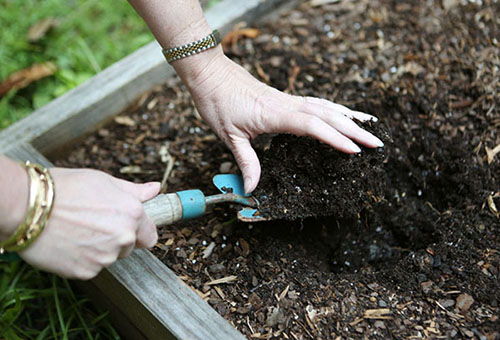
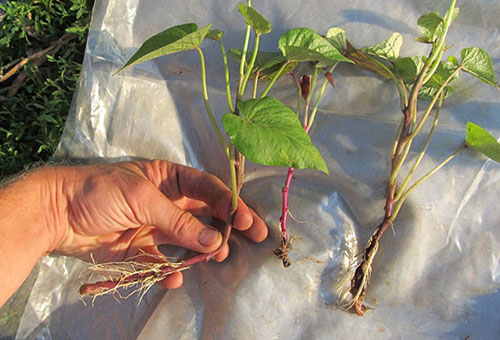
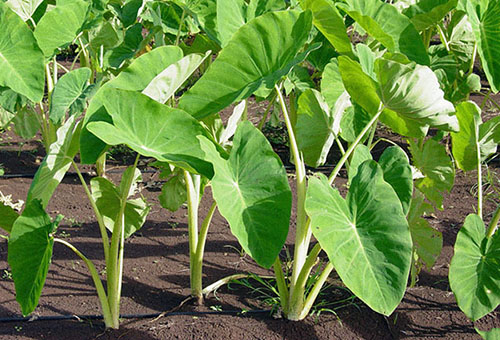
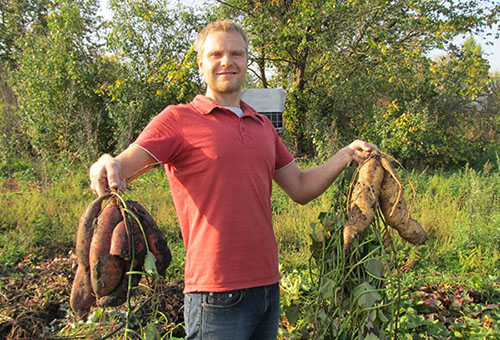

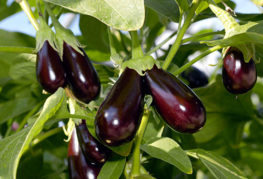


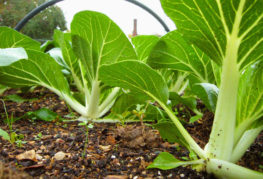
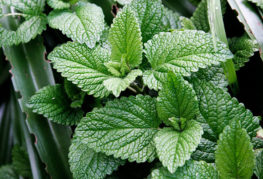
and will be published shortly.